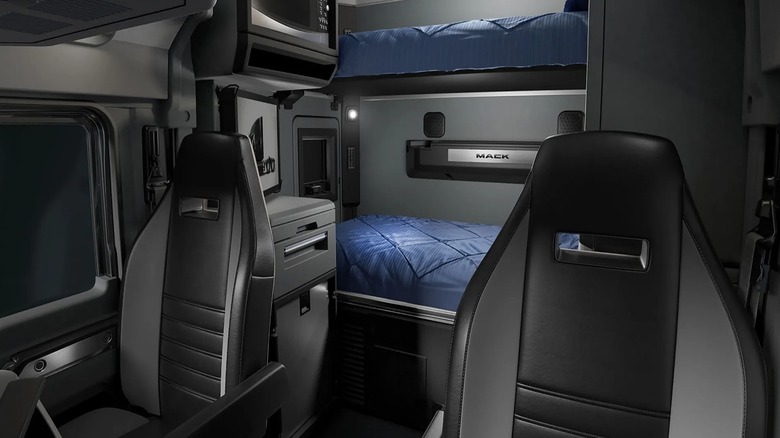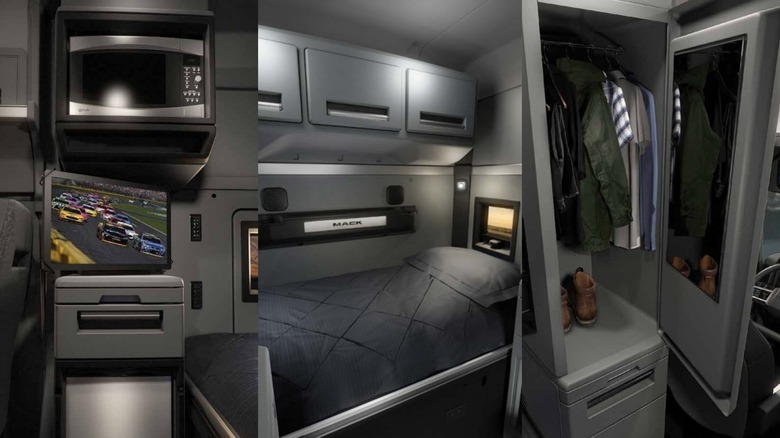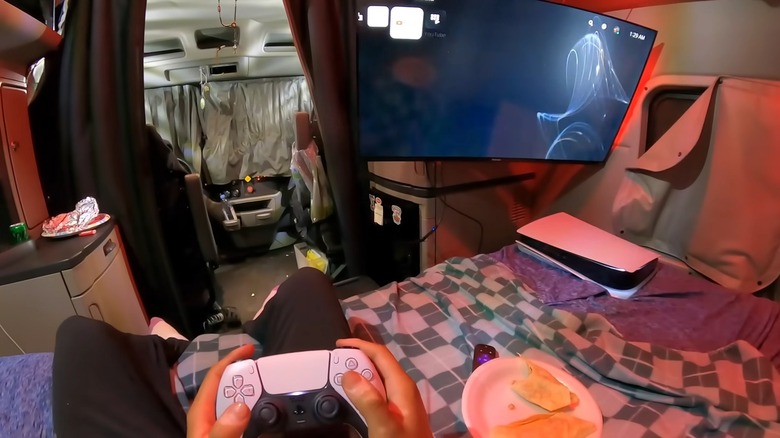Here's What The Inside Of A Semi Truck Sleeper Cab Looks Like
There are approximately 3.5 million semi truck operators in the U.S., according to Truck Info. Regional drivers can be on the road for much of the week, while over-the-road (long-haul) routes can last for multiple weeks. Fortunately, these trucks don't just provide the power to haul goods, but they also function as a home-on-wheels, with some creature comforts packed inside the cab.
Behind the front seats of many big rigs, there is another space called a sleeper cab, which becomes a driver's home away from home. With all its high-tech design, does the Tesla semi have a sleeper cabin or passenger seat? The answer might surprise you.
Depending on the truck, and any modifications made by the operator, the sleeper cab not only offers a bed, or multiple bunks in some cases, but also a variety of modern conveniences, like climate control. You can find tiny kitchenette areas that feature a microwave oven, refrigerator, and food pantry. Some models include fold-out desk surfaces, cupholders, a wall-mounted flat screen television, storage for clothes, and a windshield privacy curtain.
How much space is there and how is it maximized?
There are many different semi sleeper models, with some offering a lower flat roof, while others include a raised roof fairing, that allows drivers to stand up inside the cab. Some examples, like Mack's Anthem 70-inch sleeper, feature a rear living space up to 7-feet 11-inches tall, helping to achieve around 27 cubic feet of total room. Of course, truckers still need to avoid bringing along bulky or unnecessary items on the road, or at least find more compact solutions. There are many space-saving gadgets for tiny homes and small apartments that would also work well for a semi sleeper.
Semi sleepers take full advantage of the limited interior area by using multipurpose components and built-ins. For example, in one of Volvo's sleeper cabs, a storage cabinet next to the bunk not only offers 12-volt power outlets on top and drawers for stowing, but also a pull-out desk surface, perfect for something like a laptop. The Volvo VNL can come equipped with a unique dual-purpose furniture option that transforms a center table-top with a bench seat on each side, into a flat bunk, via sliding and folding magic.
Why these sleeper cab amenities are important in trucking
Many big rig manufacturer's design their sleeper cabs via driver input. Wesley Slavin, Peterbilt's on-highway marketing manager, (via Fleet Equipment Magazine), stated, "We develop a strong understanding of the driver comfort factor from driver interviews, product clinics and prototype testing and feedback." And beyond being just a nice option for those in the transportation industry, these sleeper cabs serve some other important purposes.
Long hours behind the wheel are hard on the body. Prolonged periods of sitting and the need for constant focus on the road create fatigue. Truckers are behind the wheel of at least 26,000 pounds of big rig and goods, must adhere to a strict schedule, and put in considerable driving hours every week. Downtime in a restful area like a sleeper cab is essential for the health and safety of truck drivers.
According to a AAA study using sample data from 2009-2013, 21% of deadly accidents involved fatigued drivers. One of the best methods for combating drowsy operators is a consistent seven hours of rest or more every night. Not only can truckers develop healthier sleeping schedules with a sleeper cab, they also aren't reliant on greasy roadside diners or fast food restaurants because they can cook their own meals. Although, whether on the road for work or pleasure, no one should miss these iconic truck stops across the US.


